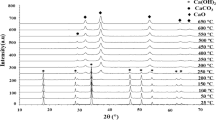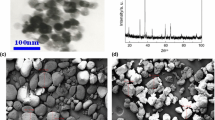Abstract
The increasing amount of chlorocarbons in our environment causes a need to find an easy, effective and inexpensive way for their destruction. Calcium oxide seems to be a good choice as the adsorbing and decomposing agent. Three different types of calcium oxide were studied to determine the amount of carbon tetrachloride that could be decomposed: commercial calcium oxide, conventionally prepared calcium oxide, and autoclave prepared calcium oxide. The amount of decomposed chlorocarbon was established using gas chromatography and the products were studied by gas chromatography-mass spectrometry. The dependence of the surface area on the decomposition was determined. We found that the best type of calcium oxide was autoclave prepared because it decomposed the most and the decomposition started at the lowest temperature, 350°C. Some fundamental studies connected with the comparison of conventionally and autoclave prepared calcium oxides are also discussed.
Access this chapter
Tax calculation will be finalised at checkout
Purchases are for personal use only
Preview
Unable to display preview. Download preview PDF.
Similar content being viewed by others
References
Hileman, B. (1993) ‘Concerns Broaden over Chlorine and Chlorinated Hydrocarbons’ C&EN April 19, 11–20
Li, Y.X.; Koper, O.; Atteya, M.; Klabunde, K.J. (1992) ‘Adsorption and Decomposition of Organophosphorus Compounds on Nanoscale Metal Oxide Particles. In-Situ GC-MS Studies of Pulsed Microreactions over Magnesium Oxide’ Chem. Mater., 4, 323–330
Koper, O.; Li, Y.X.; Klabunde, K.J. (1993) ‘Destructive Adsorption of Chlorinated Hydrocarbons on Ultrafine (Nanoscale) Particles of Calcium Oxide’ Chem. Mater., 5, 500–505
Author information
Authors and Affiliations
Editor information
Editors and Affiliations
Rights and permissions
Copyright information
© 1994 Springer Science+Business Media Dordrecht
About this chapter
Cite this chapter
Koper, O., Klabunde, K.J. (1994). Comparison of Nanoscale Calcium Oxide versus Commercial Calcium Oxide with Respect to Decomposition of Carbon Tetrachloride. In: Hadjipanayis, G.C., Siegel, R.W. (eds) Nanophase Materials. NATO ASI Series, vol 260. Springer, Dordrecht. https://doi.org/10.1007/978-94-011-1076-1_83
Download citation
DOI: https://doi.org/10.1007/978-94-011-1076-1_83
Publisher Name: Springer, Dordrecht
Print ISBN: 978-94-010-4469-1
Online ISBN: 978-94-011-1076-1
eBook Packages: Springer Book Archive




